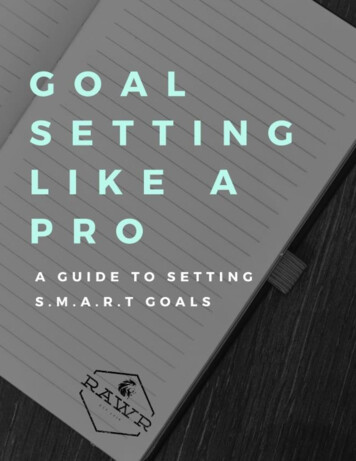
Transcription
CEDARClinical Education Development and ResearchGoal Settingin Low Intensity CBT(Physical Health Series)Paul Farrand & Joanne Woodford1
Acknowledgement:This booklet is based on the material included within ‘Reach Out: National Programme Educator Materials to Supportthe Delivery of Training for Psychological Wellbeing Practitioners Delivering Low Intensity Interventions’. 2013 The right of Paul Farrand and Joanne Woodford to be identified as the authors of this work has been asserted bythem in accordance with the Copyright, Designs and Patent Act, 1998. All rights reserved. The booklet has beenproduced on the condition that it shall not, by way of trade or otherwise, be lent, sold, hired out or otherwise circulatedin any form binding or cover other than that in which it is published and without a similar condition including thiscondition being imposed on the subsequent reader.Providing the source is fully acknowledged, all materials in this work may be freely copied, but for clinical purposesonly.Image above: Clinical Training (CEDAR) at the University of Exeter’s Streatham Campus. Image right: The Sir HenryWellcome Building for Mood Disorders Research at the University of Exeter.
ContentsPart 1Why Set New Goals?Part 2Goal Setting: The Three RulesPart 3Worksheet A: Setting S.M.A.R.T. GoalsPart 4Worksheet B: Setting Some GoalsPart 5Janet’s Recovery Story3
About the authorsDr Paul Farrand is a BABCP accredited Cognitive BehaviouralPsychotherapist, Director of Psychological Wellbeing Practitionertraining within Clinical Education Development and Research(CEDAR) at the University of Exeter and a National TeachingFellow of the Higher Education Academy (HEA). His main clinicaland research interests are in the area of low intensity cognitivebehavioural therapy (CBT), especially in a self-help format. Basedupon his research and clinical practice he has developed a widerange of written self-help treatments for depression and anxiety. Hehas operated at a national level with the Department of Healtheducation, training and accreditation committees and within theBritish Association of Behavioural and Cognitive Psychotherapies.Joanne Woodford is an Associate Research Fellow within the MoodDisorders Centre at the University of Exeter with a special interest indeveloping and improving access to evidence based psychologicalinterventions for people with depression, especially for people withco-morbid physical health difficulties, and their carers. Joanne iscurrently developing and trialling a CBT self-help intervention forinformal carers of stroke survivors as part of CEDArS, a trial fundedby the Dunhill Medical Foundation and previously co-developed anonline CBT self-help treatment for postnatal depression. Joanne isalso involved several educational programmes directed at trainingmental health professionals in the skills required to support patientsin the use of CBT self-help materials.4
Part 1Why Set New Goals?Having physical health problems can force us to change or revise the goalswe have set ourselves. Goal setting is an evidence-based interventionthat helps you decide on the new and realistic things you want to achieve,plan how to achieve them, and then progressively work towards them in astructured way that puts you in charge.Physical health difficulties can impose limitationson the things you do and sometimes the things youcan achieve. You may find that although you can stillachieve the things you want to, you need to thinkabout different ways to do them. Or you may findthat the goals you once had now need to be adaptedor even completely changed.Since developing physical health problems, you maystart to think that you can ‘no longer achieveanything’ or ‘have had to give up everything’.However, whilst having physical health problemsmay require you to do things differently, it is unlikelythat you will have to give up on things you want toachieve altogether.Setting new goals may not be as straightforward asit sounds, however. Aspects of your life before yourphysical health problem may be of little help insetting new goals and therefore it can sometimes betricky to find ways of adapting and changing yourgoals. Additionally, you may not yet know enoughabout living with your physical health problems tothink about the type of goals you can set or how toset them.By following the following three rules to goal setting,thinking S.M.A.R.T and with the help of yourPsychological Wellbeing Practitioner you can startto revise or set new goals and get your life back ontrack.You may need to think about how to achieve yourgoals differently, how to revise your goals or eventhink about setting new ones. Goal revising andsetting is therefore a useful thing to do. Revising oldgoals or setting new ones can help you to establishthe first steps towards putting your life back on track.5
Part 2Goal Setting:The Three RulesBy following the following threerules you can help yourself set newrealistic goals and take the firststeps towards slowly putting yourlife back on track. YourPsychological WellbeingPractitioner can help you with this.Three initial goal setting rules:Rule 1: Set three goalsRule 2: Focus upon short termgoalsRule 3: Set positive goalsRule 1: Set Yourself No More thanThree Goals To Begin WithThis will ensure that you do not feel initiallyoverwhelmed. Your goals will be reviewed regularly,and if you find yourself meeting them they can berevised or new ones set. As you start to get your lifeback on track you may also find yourself setting moregoals that are longer term.6Rule 2: Initially Focus upon ShortTerm GoalsInitially setting yourself short term goals will enableyou to more easily notice when you achieve them.Knowing when you have reached your goals may behelpful as it may give you a sense of achievement.Remember it may not be easy. It may take some timeto achieve your goals.If you struggle to set yourself short term goals, a tipthat can sometimes help is to change medium or longterm goals into shorter ones by breaking them down.So, for example, to ‘To clean the house’ can be brokendown into ‘To clean the lounge’ or even ‘To vacuumthe lounge for 10 minutes’. Obviously you could keepthe others as medium or long term goals. However, toget started it is better to set shorter term and morerealistic goals. As things start to improve moregenerally, with the help of your PsychologicalWellbeing Practitioner if helpful, you can then beginto set yourself a balance of short, medium and longerterm goals.Rule 3: Set Positive GoalsFinally, as we are now talking about getting your lifeback in order try to think more positively about yourgoals. Focus upon things you can achieve rather thanthose you want to reduce or drop. For example, ‘Toweed the garden for 10 minutes a day’ is better than‘To stop sitting in the lounge watching television allday’.
7
Part 3Setting S.M.A.R.T.GoalsIn addition to the three rules discussed in Part 2 it is good to also thinkabout setting S.M.A.R.T. goals. This basically means setting your goalsaccording to the following features. Use Worksheet A to help you developyour goals according to S.M.A.R.T. goals. Use it for each of the three goalsyou are setting.Sis for SpecificTry to set your goals to be as specific as possible.Where possible set dates, times, resources, etc. thatyou will need to achieve them.Mis for MeasureableGoals should be capable of being measured to allowyou to know when you have met them.Ais for AchievableYour goals should be just out of reach, but not out ofsight. Equally, the goals you set should be achievable.If you cannot achieve them you have set yourself upto fail.Ris for RelevantTry to set goals that are directly relevant to your lifeand to things that will help you get your life back inorder. Think about the things that would really makea difference to your life in the shorter term that youwould really like to be able to do again.T8is for Time SpecificSet a time by which you would like to achieve yourgoals. Over time it would be ideal to set a range ofshort, medium and long term goals. However, initiallyyou should seek to set no more than three short termgoals to focus your recovery.
Part 3Setting S.M.A.R.T. GoalsWorksheet ASetting S.M.A.R.T. GoalsWrite your original goal here:Use this space to write andthen refine your goalsaccording to S.M.A.R.T.SpecificNow ensure your goal is as specificas possible. Ensure it includes dates,times, resources, etc. that you willneed to achieve it.MeasureableNow you need to ensure the goal iscapable of being measured. If not,think about rephrasing so you canmeasure it.AchievableIs your goal achievable, and if shortterm, is it possible to be achieved inthe next couple of weeks? If not, thinkabout breaking it down.RelevantIt is best to ensure that your goal isrelevant to your life now. Willachieving the goal make a differenceto you now? If not, try to adapt it soit is.Time SpecificTry to set a time by which you wantto achieve your goal. If short term thismay be within the next week or two.If not, then go back to ‘achievable’again and think about how to adapt itto make it so.9
Part 4Setting Your GoalsIt is now time to start to think about setting your own goals. Use Worksheet B to help you do this with oneworksheet used for each goal. If this is the first time you have set your goals, then it is likely that these will beshort term. As you start to achieve these shorter term goals you will then be helped to start to make moremedium and longer term goals using additional Worksheets.Whilst it is great when you can reach your goals, you may find that this is not always possible within the timeframe you have set yourself. Maybe you set a goal that was not achievable and needed breaking down. Orpossibly the time frame was too ambitious. Not always being able to reach the goals you set yourself is perfectlynormal and to be expected. The main thing is that you discuss this with your Psychological WellbeingPractitioner, who is there to help you.RememberKeeping records of how well you haveworked towards your goals each week isessential for you and your PsychologicalWellbeing Practitioner to review yourprogress and help you continue to reachyour goals. Use the comments box inWorksheet B to record how you felttrying to reach your goals and what mayhave stopped you if you did not manage.10
11Goal Occasionally0Not at all12OccasionallyReview 4: I can do this now (circle a number):0Not at allReview 3: I can do this now (circle a number):0Not at allReview 2: I can do this now (circle a number):0Not at all333334OftenToday’s date:4OftenToday’s date:4OftenToday’s date:4OftenToday’s nytimeWorksheet B: Setting Your GoalsReview 1: I can do this now (circle a number):0Not at allI can do this now (circle a number):Today’s date:Write your goal here:Part 4Comments
Goal ReviewPart 4Write your goal here:Today’s date:1I can do this now (circle a number):0Not at all1333334OftenToday’s date:4OftenToday’s date:4OftenToday’s date:4OftenToday’s nytimeWorksheet B: Setting Your Goals2Occasionally2OccasionallyReview 1: I can do this now (circle a number):0Not at all12OccasionallyReview 2: I can do this now (circle a number):0Not at all12OccasionallyReview 3: I can do this now (circle a number):0Not at all12OccasionallyReview 4: I can do this now (circle a number):0Not at allComments12
13Goal Occasionally0Not at all12OccasionallyReview 4: I can do this now (circle a number):0Not at allReview 3: I can do this now (circle a number):0Not at allReview 2: I can do this now (circle a number):0Not at all333334OftenToday’s date:4OftenToday’s date:4OftenToday’s date:4OftenToday’s nytimeWorksheet B: Setting Your GoalsReview 1: I can do this now (circle a number):0Not at allI can do this now (circle a number):Today’s date:Write your goal here:Part 4Comments
Part 5Janet’sRecovery StoryJanet is 47 years old and was diagnosed with type 2 diabetes twelvemonths ago. She found she had never really come to terms with havingdiabetes. Although her diabetes care team were very supportive she neverreally engaged with the information they had given her about her illnessand how to manage her illness.In fact, she found she preferred to try and ignorethe fact she had diabetes altogether and had neverdiscussed having diabetes with her close friends. Notonly at times did this result in physical problems, butover time it was beginning to affect her social life.Initially when she went out for a meal with her friendsshe tried to appear ‘normal’ and eat what she wantedto avoid them asking any questions. However bydoing this her blood glucose levels becameunmanaged and caused her to feel ill. More recentlyshe stopped going out with her friends altogether.This was affecting her mood, she began to feelincreasingly isolated and alone, and this was makingher feel low. Ironically she found that she had alsostarted to eat more and put on weight which was areal cause for concern for her diabetes care team whowere keen to support her taking better care of herself.One Saturday evening, whilst sitting alone at home,she decided she needed to do something about howshe felt and decided to discuss her low mood with hernurse, Peter.Peter listened to Janet and made a referral to the‘Speak Easy’ service which could be accessed throughher GP practice. Three weeks later Janet found herselftalking to Sarah, a Psychological WellbeingPractitioner, about her low mood and feelings ofisolation, the things ‘going through her head’, and‘what she was doing more or less of’. Sarah alsoenquired about how Janet was managing to deal withher diabetes since being diagnosed and spoke about atransition people go through when they become14physically ill. Janet found this really helpful as sherealised that difficulties coming to terms with aphysical illness were quite common. She also learnthowever, that by ignoring her physical healthproblems she was making not only her physical healthworse, but it was also affecting her mental health. Inparticular she was intrigued about how her low moodmay be related to her eating more, and how this wasmaking her put on weight and affecting her diabetes.Janet had never thought of relating how she feltemotionally to her physical health before. At the endof the assessment session, for the first time Janet feltlike she wanted to know a little more about herdiabetes. Sarah informed Janet that she was notmedically qualified and knew very little aboutdiabetes herself, but could recommend and excellentweb site ‘NHS Choices’ and encouraged Janet alsospeak to her diabetes care team.The following week Janet turned up to her firstappointment. During the session, Sarah first recappedthe previous week and then enquired about theinformation Janet had found out about her diabetes.Janet talked about how she found NHS Choicesreally helpful, but the most helpful thing was talkingto Peter who gave her lots of information again aboutliving with diabetes and the things she could do tohelp herself. For the first time she found that she wasactually willing to listen to what Peter had to say. Afterdiscussing this, Janet and Sarah discussed togetherthe range of interventions that may be helpful forJanet. In particular, Sarah highlighted the possibility
that ‘Goal Setting’ may be helpful in supporting Janetto think about getting her life back on track. Sarahtalked through goal setting and how there was goodevidence to support its use amongst people followinga physical illness. She then discussed how to do it andtalked her through a ‘recovery guide’. Sarah stressedthat following physical illness people sometimes needto focus on their goals. At times it may be possible tokeep the same goals, but potentially people may haveto achieve them in different ways. Otherwise, goalsmay have to be revised or indeed old goals may needto be dropped and new ones developed. Sarah wasclear to stress that it was not necessary to give up ongoals completely following physical illness.With Sarah’s support she then used Worksheet A toensure that each goal was S.M.A.R.T. She found thisreally helpful as she noticed how her original goalsnot only became much clearer and more explicit, butalso more manageable and they appeared much lessoverwhelming.With the aid of herPsychologicalWellbeing PractitionerJanet started to thinkabout setting andrevising her goals toaccommodate herphysical illness.To begin with, Sarah started to take Janet through the‘Goal Setting Recovery Workbook’. This was reallyhelpful, as going through the ‘Three Rules of GoalSetting’ helped Janet to think about how to set hergoals. Once she appreciated this, Janet then started tothink about how to set each of her three short termsgoals using S.M.A.R.T. She did this by going throughWorksheet A for each of her goals separately.Janet started to think about what short term goalsshe would like to set herself. Considering her diabetes,and on the basis of the discussion she had with Peter,she decided that the best short term goals she couldset herself would all be related to taking better care ofherself. Therefore, she decided to set herself thefollowing three short term three goals – To getfitter, To lose weight, To tell my friends aboutmy diabetes.15
Setting Janet’s S.M.A.R.T. GoalsWorksheet ASetting S.M.A.R.T. GoalsWrite your original goal here:To be fitter.Use this space to write andthen refine your goalsaccording to S.M.A.R.T.SpecificMeasureable16Now ensure your goal is as specificas possible. Ensure it includes dates,times, resources, etc. that you willneed to achieve it.Now you need to ensure the goal iscapable of being measured. If not,think about rephrasing so you canmeasure it.AchievableIs your goal achievable, and if shortterm, is it possible to be achieved inthe next couple of weeks? If not, thinkabout breaking it down.RelevantIt is best to ensure that your goal isrelevant to your life now. Willachieving the goal make a differenceto you now? If not, try to adapt it soit is.Time SpecificTry to set a time by which you wantto achieve your goal. If short term thismay be within the next week or two.If not, then go back to ‘achievable’again and think about how to adapt itto make it so.To be fitter.Next week become fitter bywalking more to workNext week become fitter bywalking more to work.Walk to work for at least 30minutes every day by the end ofnext month.Walk to work for at least 30minutes every day by the end ofnext month.Walk to work for at least 10minutes on three days next week.Walk to work for at least 10minutes on three days next week.Walk to work for at least 10minutes on three days next week.
Once Janet had made each of her three goalsS.M.A.R.T., she then transferred each one ontoWorksheet B. With respect to her goal ‘Walk towork for at least 10 minutes on three days nextweek’ Janet was reasonably confident that she couldachieve this goal, but as she had done so little for solong felt it better to set a goal she was confident wasachievable. However on the first day of doing thisgoal she realised that finding even 10 minutes onthree days during the week was more difficult thanshe anticipated. However, she discussed this throughwith her partner, who suggested that a good idea maybe to park the car 10 minutes from work and to findthe time that way. She therefore revised her goal againas written at the top of Worksheet B to include thisnew information. The solution worked really well andJanet was able to achieve her goal for the rest of thatweek and during the following week.During the next few weeks Janet went from strengthto strength. Sarah continued to help her revise hergoals and each week Janet continued to meet them.By the end of treatment Janet was far better in controlof her diabetes, was looking after herself much better,and was now working towards her medium and longterm goals.At her next appointment with Sarah, Janet discussedher progress on her goals. Whilst she had achievedtwo of her goals – ‘Park the car 1o minutes fromwork and walk to work on three days next week’and ‘Discuss my diabetes with Helen and Rashmi’,she was still struggling to achieve her third goal ‘Tolose half a kilogram by next week’. Sarahhighlighted how it was great that Janet has alreadymet two of her goals, and it was fine that she was stillworking on her third goal.Given that Janet had achieved two of her goals, Sarahdiscussed the possibly of setting new goals to worktowards. Janet was keen to keep her goal related towalking, but was keen to increase this to get evenfitter. She used the S.M.A.R.T. Worksheet A againand revised this goal upwards to ‘Park the car 15minutes from work and walk to workeveryday next week’ . They also discusseddeveloping a new goal to replace the one aboutdiscussing her diabetes with her friends. After somethought she decided she would like to set a longerterm goal. As she was now feeling better again, andmore on top of her diabetes, it might be a good timeto think about getting promoted at work. Shetherefore set herself a medium term goal of ‘To getpromoted to team leader by the end of next year’ towork towards.17
Goal ReviewPart 4Worksheet B: Setting Your Goals2Occasionally333334OftenToday’s date:4OftenToday’s date:4OftenToday’s date:4OftenToday’s nytimeWalk to work for at least 10 minutes on three days next week.Park the car 1o minutes from work and walk to work on three days next week.17th April, 2012Write your goal here:Today’s date:1I can do this now (circle a number):0Not at all12OccasionallyReview 1: I can do this now (circle a number):0Not at all12OccasionallyReview 2: I can do this now (circle a number):0Not at all12OccasionallyReview 3: I can do this now (circle a number):0Not at all12OccasionallyReview 4: I can do this now (circle a number):0Not at allCommentsSince being diagnosed I have doneso little that I am really unfit.Will be good to see if I can do this.I was surprised how easy this wasin terms of doing it. However Istruggled to find the time on thefirst day, but worked this out now.This was no problem , I simplypark my car further from workand walk.18
Setting S.M.A.R.T. GoalsWorksheet ASetting S.M.A.R.T. GoalsWrite your original goal here:Use this space to write andthen refine your goalsaccording to S.M.A.R.T.SpecificNow ensure your goal is as specificas possible. Ensure it includes dates,times, resources, etc. that you willneed to achieve it.MeasureableNow you need to ensure the goal iscapable of being measured. If not,think about rephrasing so you canmeasure it.AchievableIs your goal achievable, and if shortterm, is it possible to be achieved inthe next couple of weeks? If not, thinkabout breaking it down.RelevantIt is best to ensure that your goal isrelevant to your life now. Willachieving the goal make a differenceto you now? If not, try to adapt it soit is.Time SpecificTry to set a time by which you wantto achieve your goal. If short term thismay be within the next week or two.If not, then go back to ‘achievable’again and think about how to adapt itto make it so.19
CEDARClinical Education Development and ResearchUniversity of ExeterWashington Singer BuildingPerry RoadExeter EX4 4QGUnited KingdomTo download a copy of this workbook go to:www.exeter.ac.uk/cedarPhotography by: Tim Gulick, Piotr Lewandowski, Shannon Pifko, Nevit Dilmen andJanusz Gawron20
Setting S.M.A.R.T. Goals Part 3 In addition to the three rules discussed in Part 2 it is good to also think about setting S.M.A.R.T. goals. This basically means setting your goals according to the following features. Use Worksheet A to help you develop your goals according to S.M.A.R.T. goals. Use it for each of the three










